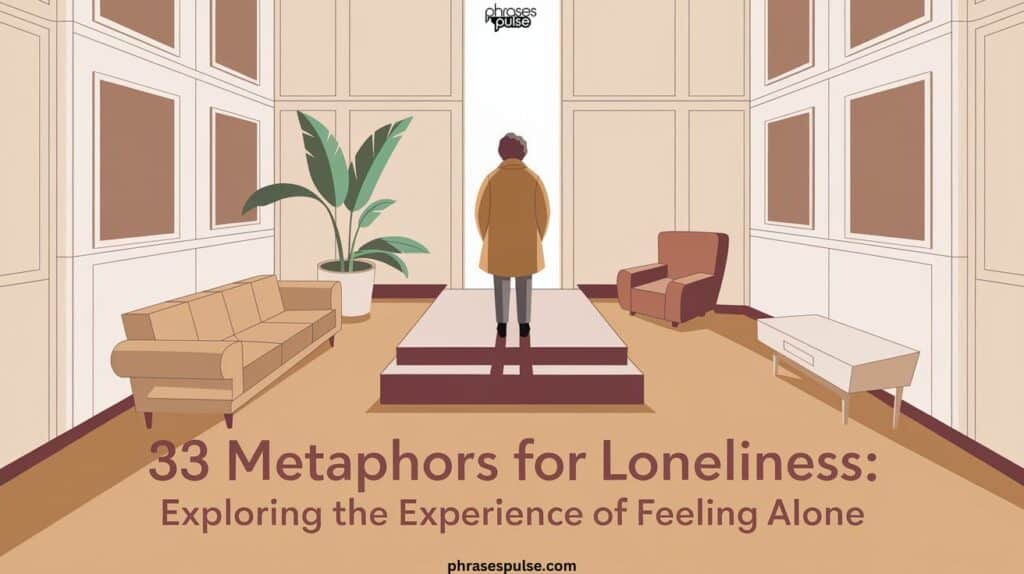Loneliness is a profound and often painful part of the human experience. At one time or another, everyone feels it this deep, almost tangible sense of being apart from others. Through metaphors for loneliness, we can better understand this feeling, describing it in ways that make it easier to relate to and talk about.
Metaphors offer us vivid, often poetic descriptions that capture the complexity of being alone. Whether it’s the image of a dark cloud hanging over us or the sensation of a cold winter night, these expressions bring the feeling of loneliness to life.
For those who’ve struggled with intense feelings of loneliness, metaphors can provide comfort by giving voice to emotions that are hard to express. They help us relate, showing that we’re not truly alone in how we feel.
This article explores 33 metaphors, each capturing a unique shade of loneliness and inviting readers to see their emotional separation in new ways. Each metaphor here offers a different perspective on loneliness, giving readers a chance to reflect, connect, and understand.
Metaphors for Loneliness That Create a Deep Impact on Human Life

Loneliness, though a universal emotion, feels deeply personal and often isolating. Metaphors for loneliness can create a powerful impact, allowing us to explore our emotional experiences more fully.
When people talk about loneliness, they often describe it as a heavy weight or a feeling of being trapped in a void of loneliness. Such expressions show us how different individuals may perceive loneliness sometimes as an external force pressing down, other times as an inner emptiness.
Consider the imagery of a single candle in the darkness. This metaphor speaks to those moments when we feel isolated, yet still have a glimmer of hope. Or, think of loneliness as an empty room a lonely space filled with silence, reflecting the vast emptiness that many experience when they are cut off from others.
These metaphors help to create a sense of solidarity, reminding us that many have felt the same kind of profound loneliness.
Metaphors for Loneliness
Loneliness can take many forms, and metaphors help capture its various dimensions. Here, we break down 33 metaphors for loneliness in table form, complete with examples to illustrate each metaphor’s unique expression. Dividing these metaphors into three categories, we look at loneliness as isolation, emptiness, and darkness.
Loneliness as Isolation
This first group of metaphors portrays loneliness as a separation from others or a feeling of being stranded. These metaphors often emphasize the sense of disconnection and detachment that comes with being alone.
| Metaphor | Description | Example |
|---|---|---|
| Deserted Island | Feeling completely isolated, as if stranded with no one around. | “After moving to a new city, she felt like she was on a deserted island, surrounded by strangers.” |
| Locked Door | A barrier to connection, making one feel isolated and shut out. | “It felt like there was a locked door between him and everyone else, preventing any meaningful connection.” |
| Ship Lost at Sea | Adrift and aimless, like being lost in a vast, empty ocean. | “In his depression, he felt like a ship lost at sea, with no destination or compass to guide him.” |
| Echoes in an Empty Canyon | The feeling of calling out but not being heard, like a voice echoing without response. | “Her messages felt like echoes in an empty canyon, always reaching out but never receiving a reply.” |
| Single Star in the Night Sky | Feeling unique yet alone, like a single point of light in a vast, dark sky. | “In her success, she felt like a single star in the night sky, admired but completely alone.” |
| Cage of Loneliness | Feeling trapped within oneself, unable to connect with others. | “He felt locked in a cage of loneliness, visible to others but completely out of reach.” |
| Silent Forest | Being surrounded by silence, as if in an empty, soundless forest. | “Her life felt like a silent forest, where no voices or sounds disturbed the loneliness she felt.” |
| Prison Cell | A sense of being trapped in isolation, as if locked in a cell with no escape. | “Living in isolation felt like a prison cell, confined and restricted with no way to break free.” |
| Deserted Playground | A place once full of joy now empty, reflecting a loss of connection and community. | “Returning to his childhood town, he felt like he was standing in a deserted playground, lonely and empty.” |
| Desolate Island | Feeling like there’s no one else, like being stranded in a far-off, desolate place. | “Her new job felt like a desolate island, with no friends or family nearby for support.” |
| Barrier to Connection | Imagining loneliness as an unseen wall preventing closeness. | “He felt a constant barrier to connection, unable to bridge the gap between himself and others.” |
Loneliness as Emptiness
The next group of metaphors captures loneliness as a state of emptiness or hollowness, often invoking spaces that are vacant or abandoned. These metaphors illustrate how loneliness can feel like a void or a place devoid of warmth and life.
| Metaphor | Description | Example |
|---|---|---|
| Empty Room | A quiet, vacant space filled with silence and solitude. | “Walking into his new apartment felt like stepping into an empty room, devoid of any sense of warmth.” |
| Vacant Home | An abandoned space that once held life, now empty. | “Since her children moved out, her house felt like a vacant home, silent and lonely.” |
| Empty Nest | A place where family once gathered, now quiet and lonely. | “After his parents passed, he was left with an empty nest, full of memories but devoid of presence.” |
| Echoing Hallway | A space that amplifies emptiness, like a hallway where each sound fades into silence. | “The office felt like an echoing hallway after everyone left, with only his footsteps to break the silence.” |
| Empty Playground | A place meant for laughter and joy, now silent and still. | “The empty playground seemed to mirror her own loneliness, once full of life but now quiet and abandoned.” |
| Mirror of Emptiness | Reflecting back an image of void, showing the hollow feeling of being alone. | “Staring at herself in the mirror felt like looking into a mirror of emptiness, her loneliness reflected back.” |
| Hole of Loneliness | A deep sense of emptiness, as if there’s a void within. | “Each day felt like she was sinking into a hole of loneliness, deeper and darker.” |
| Void of Loneliness | A vast, empty space that feels boundless, with no end in sight. | “In his grief, he found himself lost in a void of loneliness, vast and all-encompassing.” |
| Empty Canyon | An expansive, deserted place that echoes solitude. | “Walking alone in her feelings was like being in an empty canyon, where her voice went unheard.” |
| Desert Metaphor for Loneliness | Feeling alone as if stranded in a vast, desolate desert. | “After the breakup, he wandered through life like a desert, barren and without companionship.” |
| Labyrinth Metaphor | A maze of loneliness with no clear way out. | “Her thoughts were a labyrinth of loneliness, twisting and turning but leading nowhere.” |
Loneliness as Darkness
This final group of metaphors presents loneliness as a form of darkness, where images of shadows, tunnels, and night capture the isolating and sometimes overwhelming nature of being alone.
| Metaphor | Description | Example |
|---|---|---|
| Dark Cloud | A persistent sadness, like a cloud casting shadows on joy. | “Wherever he went, he felt a dark cloud following him, clouding any happiness.” |
| Cold Winter Night | The harsh, isolating cold that makes one feel alone. | “Living alone felt like a cold winter night, quiet and freezing, without the warmth of companionship.” |
| Shadow in the Crowd | Feeling unnoticed and invisible, even in a group. | “She felt like a shadow in the crowd, surrounded by people but utterly alone.” |
| Single Candle in Darkness | A faint glimmer of hope amidst the darkness of loneliness. | “Even in her loneliness, she held onto a single candle in darkness, a small light of hope.” |
| Dark Tunnel Loneliness | A feeling of being trapped in darkness with no end in sight. | “His depression felt like walking through a dark tunnel, endless and isolating.” |
| Black Hole Loneliness | A force that pulls everything inward, trapping light and warmth. | “Her loneliness felt like a black hole, absorbing any joy or comfort around her.” |
| Cold Wind on a Winter Night | The chilling, empty feeling that cuts through, like a winter breeze. | “The cold wind on a winter night reminded her of her loneliness, biting and relentless.” |
| Dark Alley Loneliness | The isolation of a shadowy, deserted path. | “Being single felt like walking down a dark alley, alone and without a clear direction.” |
| Loneliness as a Shadow | A persistent feeling that follows and lingers, even when unobserved. | “No matter how hard she tried to ignore it, loneliness lingered like a shadow.” |
| Ghost of Loneliness | The haunting presence of past losses that keeps one feeling alone. | “The memory of her friend felt like a ghost of loneliness, always near but unreachable.” |
| River of Loneliness | A continuous flow of sorrow, like an unending river. | “Her emotions felt like a river of loneliness, always flowing but never reaching anyone.” |
Each metaphor provides a unique lens to view and understand the multifaceted experience of loneliness. By exploring loneliness as isolation, emptiness, and darkness, we see how this complex feeling manifests in various ways. Whether you’re feeling like a deserted island or a shadow in the crowd, know that these metaphors give voice to a shared human experience.
What is a Metaphor?
A metaphor is a figure of speech that describes one thing as if it were another. For example, saying loneliness feels like a “cold winter night” uses metaphor to convey the chill of being alone. Metaphors are especially helpful when describing complex emotions like loneliness because they make feelings easier to understand. Metaphors for loneliness often involve images of cold, darkness, or isolation capturing the essence of what it’s like to feel disconnected from others.
By transforming emotions into familiar, sensory experiences, metaphors help us connect with each other. Solitude imagery and isolation metaphors show how words can bridge the gap between shared human emotions and individual experiences.
When to Use a Metaphor for Loneliness
Using metaphors to describe loneliness is helpful in many situations. Writers and poets use them to give readers a glimpse into complex emotions. Therapists might encourage clients to express their feelings of loneliness through metaphor as a way to work through difficult emotions. Even in personal reflection, metaphors can clarify our own experiences, helping us make sense of what it means to feel alone.
Metaphors can also deepen our empathy. When you hear someone describe loneliness as a single star in the night sky, it’s easier to understand their solitude. This poetic language adds richness to the experience of being alone and can bring comfort in knowing that these loneliness metaphors resonate with others.
History of Metaphors for Being Alone
Metaphors for being alone have existed for centuries. In literature, writers like Shakespeare often used loneliness expressions to explore characters’ inner struggles. Historical texts reveal how people have long described loneliness as an isolation room or a dark tunnel, showing the persistent, almost timeless nature of these feelings. Art and literature use loneliness imagery to connect audiences with a universal sense of solitude.
Today, metaphors continue to evolve. In modern media, loneliness is often depicted as a shadow in the crowd or a ship lost at sea. These images provide new ways to understand the psychological impact of loneliness on the human nature. Whether we’re looking at past or present descriptions, metaphors remain a vital tool for exploring the depths of being alone.
Frequently Asked Questions
What is a loneliness metaphor?
A loneliness metaphor is a way of describing the feeling of being alone or disconnected by comparing it to something relatable and vivid. For example, “a single candle in the darkness” conveys a sense of solitude with a hint of hope, while “a ship lost at sea” illustrates feeling adrift and isolated.
What is a simile for lonely as a metaphor?
A simile that acts like a metaphor for loneliness compares the feeling to a relatable image using “like” or “as.” For instance, “lonely as a shadow in the crowd” evokes the idea of being unnoticed and disconnected, even in a busy place. This simile turns an abstract feeling into something visually relatable.
What is a metaphor for feeling empty?
To describe feeling empty, metaphors often use imagery that captures emptiness and isolation. “An empty room” symbolizes a sense of vacancy, while “a hollow shell” conveys feeling incomplete or drained. These metaphors help express emotional emptiness in a tangible way.
How do you describe feelings of loneliness?
Feelings of loneliness can be described through expressions of emotional distance or isolation. Words like “disconnected,” “isolated,” or “invisible” paint a clear picture of the loneliness experience. Metaphors like “a locked door” or “a dark cloud” create vivid descriptions, capturing the heaviness and isolation often associated with loneliness.
Conclusion
Loneliness is a universal feeling, yet it’s hard to explain. Through 33 metaphors for loneliness, we gain new insights into this complex emotion, discovering the many ways it shapes our lives. From the cold winter night to the image of a dark cloud, each metaphor adds depth to the experience of profound loneliness. These descriptions connect us to a broader world, showing that our feelings are shared.
If you’ve ever felt the weight of being alone, remember that others have been there too. Let these metaphors serve as a reminder that, while loneliness is real, understanding it is the first step to finding connection.

Ava Rose, the creator of PhrasesPulse, is an expert in English grammar with years of experience. She is dedicated to simplifying complex grammar rules and exploring the richness of English phrases. Through her insightful posts, Ava aims to help learners of all levels enhance their understanding of the language and communicate more effectively. Her passion is making grammar approachable and enjoyable for everyone.







